|
|
The Finn

|
|
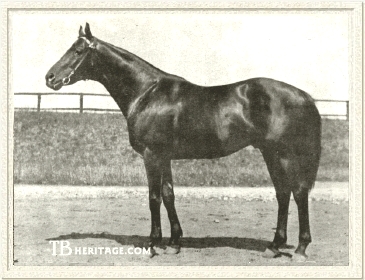 |
|
|
The name of The Finn is not one that springs to mind when noting great runners, great sires, or sires of sires. On the other hand, The Finn was a top class racehorse, a champion sire in his day, and, as a sire of several useful stallions, an important link in his sireline to the future. He did everything a horse could be asked to do, and his premature death was probably a loss to American breeding.
The Finn was bred by John E. Madden and foaled at his breeder's farm, Hamburg Place, on the east side of Lexington, Kentucky. He was a son of one of Madden's home sires, *Ogden (1894 by Kilwarlin), who had been imported with his dam *Oriole (by Bend Or) when a suckling by copper magnate Marcus Daly, and raised at Daly's Bitter Root Stud in Montana. *Ogden's sire Kilwarlin was a stayer like many from his sireline descending from Melbourne, in this case through Melbourne's son West Australian, his son Solon, and Solon's son Arbitrator, sire of Kilwarlin.
*Ogden's dam, *Oriole was by Bend Or, and was a half-sister to the important broodmares Douranee (granddam of Gondolette and Grey Leg) and Orsova (granddam of German Derby winner Orchidee II). *Oriole did little other than produce *Ogden, but that was enough.
|
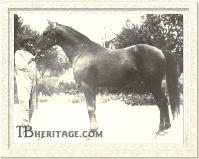
The Finn's sire, imported Ogden
| |
*Ogden was an exceptional juvenile whose wins took him from Montana to Coney Island, where he won the Futurity in 1896, the crown jewel of the 2-year-old season. The rest of the crop caught up with *Ogden at 3, but he grew into a fair handicapper before being retired to stud at Bitter Root, where he stood at 5 and 6. Marcus Daly died in 1900 and his stud was dispersed in 1901. *Ogden was sold to his former trainer, Billy Lakeland for $5,000, who knew what he had and put the stallion back into training. At the age of 7, he won 6 more races and was retired again, proving himself a sound, game horse with a lot of speed, if a little short on stamina.
|
*Ogden was purchased by John Madden and stood at Hamburg Place, where he thrived. His best was American's champion 2-year-old Sir Martin (a half-brother to Sir Barton), who was highly thought of in England before his run in the 1909 Derby was foiled by a suffragette making a fatal political statement. *Ogden's best American runner was the subject of this essay, The Finn. Other good ones included the outstanding handicap mare Flora Fina, Fayette, Belmere, Star Jasmine, Paris and Captain Alcock. He specialized in precocious juveniles like himself, but also got some good stayers.
The Finn's dam was Livonia (1907), a chestnut daughter of Star Shoot and Woodray by *Rayon d'Or. Livonia had been a stakes winner at 2. Although her dam, Woodray and granddam Wood-Nymph had done little as producers, Livonia's third dam, Woodbine, was August Belmont's great homebred racemare and dam herself of the champion 3-year-old and Belmont Stakes winner Forester.
Livonia was bred as a 4-year-old to *Ogden and produced a black colt the following spring, in 1912. Livonia was named for a region spreading across Latvia and Estonia in central Europe, and bordering on the Baltic Sea. Her black colt was named The Finn in honor of another Baltic nation, Finland.
The Finn on the Turf
Racing initially for his breeder, John Madden, The Finn made 9 starts at 2, winning 3 times. After a third, an unplaced effort, and a second, he broke his maiden in his fourth start, and broke the track record at Aqueduct for 5 furlongs in the process. He also won a pair of handicaps, but failed to finish in the valuable Futurity, after veering into the rain and thereby losing his rider in the final quarter mile. Prior to the Futurity, Madden sold The Finn to Louis Winans, who, apparently disgusted with the colt's performance in the big race, sold him to H.C. Hallenbeck for a reported $15,000.
For Hallenbeck The Finn raced with much success at 3, with 9 wins in 20 starst, 4 times second and twice third. His season debut was a second place in the Littleneck Handicap (5.5f.) at Belmont, but he returned to post facile victories in both the Withers Stakes (8f.), and Belmont Stakes (11f.). The Finn followed up with wins in the Southampton Handicap, toting 126 pounds and winning easily, and the Hamiton Derby (in Canada). He was second to Waterblossom by a head in the Canadian Derby (10f.) at Fort Erie. After unplaced efforts in the Knickerbocker, Champlain, and Saranac Handicaps, he won the Huron Handicap (11.5f.). In the Autumn Handicap at Belmont, he went under to Stromboli.
The Finn later beat Short Grass in the Baltimore Handicap, won the Ellicott City Handicap, and the Dixie Handicap in his season finale. It's worth noting that the last three races were run on off tracks. He is generally considered to have been the best 3-year-old in training that season, although there was no year-end election or award to acknowledge it at that time.
Returning at 4, The Finn started 14 times, winning 6 races, including the Metropolitan Handicap (8f.), Champlain Handicap (9f.), Merchants and Citizens H. (11.5f. equaling the track record), Chesterbrook Handicap, Manhattan Handicap, and Havre de Grace Handicap (9f.). His stiffest competition that year was the champion 3-year-old and great stayer Friar Rock, the aged *Short Grass, and the good gelding Stromboli. At 5, The Finn won only once in 7 starts, in the Long Beach Handicap (9f.), again equaling a track record, defeating Kentucky Derby winner George Smith among others. He was also second that season in the King's County, Suburban, and Carter Handicaps.
The Finn came out of the Brookdale Handicap lame (the winner, Boots equaled the American record for 9 furlongs), and did not train well thereafter and was retired with 19 wins in 50 starts and $38,965. He had proven himself a good but not great runner, although at or near the top of his division at 3 and 4. He was a good middle distance runner who could handle weights and loved a heavy racetrack.
The Finn in the Stud
The Finn was a strongly made horse with good bone. Well balanced, with a good shoulder and hindquarter, he was short backed, with a well-angled hind leg and short cannon. He was solid black with no white markings.
|
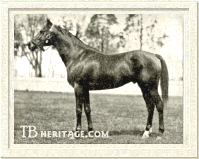
Kai-Sang
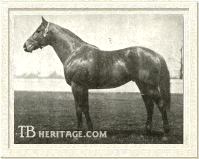
Zev
| |
Still owned by Hallenbeck, The Finn went home to Hamburg Place to stand his initial season in 1918. The first crop included Kai-Sang (1919 out of Kiluna by Golden Maxim), a colt who won the Jerome Handicap and Lawrence Realization at 3. Kai-Sang became a useful sire of 9 stakes winners for 137 foals, led by Khara (Selima Stakes at 2), Repaid (Junior Champion Stakes at 2), Mei Foo (Hudson Stakes at 3, Paumonok Handicap at 4). Kai-Sang's sons Kai-Feng and Kai Finn were both useful sires.
Khara became an extremely important broodmare through her offspring, the full siblings Aethelwold, Savage Beauty and Little Sphinx, all by Challenger II. Aethelwold and Savage Beauty were stakes winners. Savage Beauty produced Santa Susana Stakes winner Femme Fatale and the winner Little Hut, dam of stakes winners and important sires (and broodmare sires) Habitat and Northfields. Little Sphinx produced 3 stakes winners, Equichall, Captor, and Glad, and several of her daughters were important producers. The Ghizeh was the dam of Champion Steeplechaser Quick Pitch. Sphinxlike produced Canadian Oaks winner Northern Minx and stakes winner Denim King. Noors Image produced the stakes winners Sailing Chance and Dancer's Image, the latter winner of the Wood Memorial, and first in the Kentucky Derby but disqualified rather infamously due to an illegal drug found in his system.
|
The Finn's second crop was led by Zev (1920 out of Miss Kearney by Planudes), who reigned as champion at 2 and 3, and won the Kentucky Derby and match races with In Memoriam and Derby winner Papyrus. His 3-year-old form helped lead The Finn to the Leading Sire title of 1923. Zev ultimately earned $313,639, but was unfortunately, a terrible sire, with only 2 stakes winners to his credit, Zevson and Zida.
Another colt from The Finn's second crop was Bud Lerner (1920 out of Dreamsome by Superman), a good 2-year-old and a better sire. His chief earners included 14 stakes winners topped by the good colt Mokatam and Travers Stakes winner Thanksgiving (out of the top filly Inchcape Belle). Mokatam sired the mare Twink-Mo, dam of Uncle Miltie (Champagne Stakes at 2, etc.). Thanksgiving sired only 43 foals and 1 stakes winner, the filly Bertie S., but his son Thirteen (1942 out of Go Seek by Bold Venture), a winner of 2 races, went to stud in Puerto Rico and sired one of their all-time greats in Camarero (1951), a Triple Crown winner who set a world record with 56 consecutive wins. |
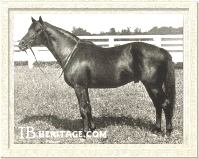
Flying Ebony
| |
The Finn got another Kentucky Derby winner in Flying Ebony (1922 out of Princess Mary by Hessian), who himself became a good sire, getting the really good runners Flying Heels, Dark Secret, and the siblings Vicar and Vicaress. Flying Heels (1927 out of Heeltaps by Ultimus) won top stakes at 2, 3, 4, 5, and 6, earning $123,435, and became a successful sire in his own right, with 13 stakes winners including Kentucky Oaks winner Flying Lill and the stakes winning mare Throttle Wide (dam of champion filly Miss Request and important broodmare Fast Line). |
Another daughter of Flying Heels, Flittingfeet produced 3 stakes winners in California including Fleet Khal. Flittingfeet was particularly notable since her dam was Karnatah, by Bud Lerner, and so she was inbred to The Finn. Dark Secret broke down and died in training, so didn't get the chance to pass on the line.
The Finn also sired the good gelding Finite (out of Last Straw by Ultimus) from his 1925 crop. Finite won stakes every year from age 2 to 5, including the Babylon, Fall Highweight, Capital and Interborough Handicaps.
The Finn sired several good sire sons, such as Flying Ebony, Kai-Sang, and Bud Lerner, although the sireline seems to have died out in the 1950s with Camarero. The Finn's daughters left very little mark, however.
In 1922, The Finn's owner, Mr. Hallenbeck, upon whose death, Madden purchased the stallion from the estate. In 1922, the brothers Montfort and B.B. Jones, of Audley Farm in Virginia, purchased a half-interest in The Finn. In 1923, the year Zev dominated and led The Finn to the top of the sires' list, the partners sold The Finn to W.R. Coe for $110,000. The black stallion was moved to Coe's Shoshone Stud, which was actually located on Hinata Farm, which Coe leased. Tragedy struck just 2 years later, when The Finn died from "inflammation of the bowels" on September 4, 1925 at the young age of 13. He had sired only 134 foals, 16 of which were stakes winners (11.9%). He had led the sire lists in 1923, and was among the leading sires in both 1922 and 1925 as well.
--Anne Peters
|
|
|
|

